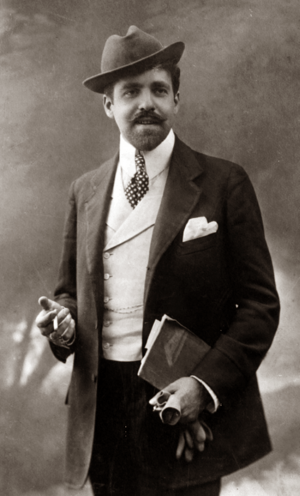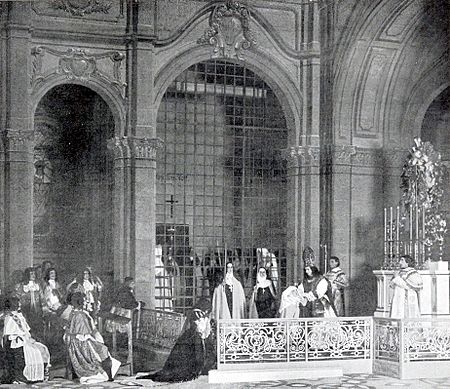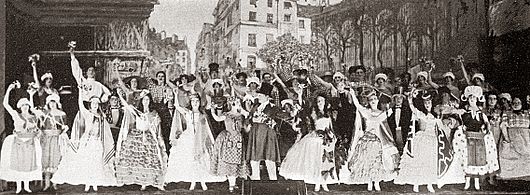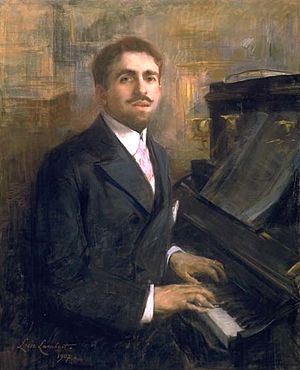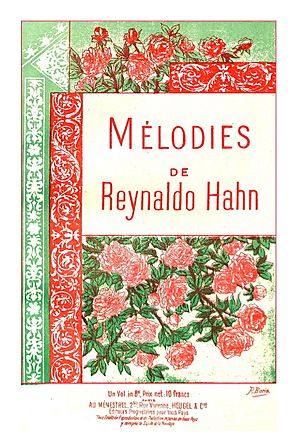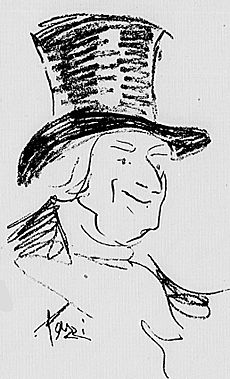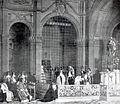Reynaldo Hahn facts for kids
Reynaldo Hahn de Echenagucia (born August 9, 1874 – died January 28, 1947) was a talented composer, conductor, music critic, and singer. He was born in Venezuela but became a French citizen. He is most famous for his beautiful songs, called mélodies, of which he wrote over 100.
Hahn moved to Paris with his family when he was a young child and lived there for most of his life. He became well-known at age 14 after writing his song "Si mes vers avaient des ailes" (If my verses had wings). He became friends with many important people in French society, including the famous actress Sarah Bernhardt and the writer Marcel Proust. After serving in the First World War, Hahn wrote successful musical plays like Ciboulette (1923) and Mozart (1926). During the Second World War, Hahn, who had Jewish heritage, found safety in Monaco. He returned to Paris in 1945 and became the director of the Opéra. He passed away in Paris in 1947 at the age of 72.
Hahn created a lot of music. He wrote songs for singers, operas, and operettas. He also composed music for orchestras, including ballets and music for plays and movies. He wrote chamber music and piano pieces too. Hahn often sang and played his own songs, and he made recordings. After his death, his music was not played as much, but since the late 1900s, people have become more interested in his works. Many of his pieces are now performed and recorded often.
Contents
Early Life and Musical Start
Reynaldo Hahn was born in Caracas, Venezuela, on August 9, 1874. He was the youngest of many children. His father, Carlos Hahn, was a successful businessman from Hamburg, Germany. His mother, Elena María de Echenagucia, had Spanish and Dutch-English family roots. Reynaldo grew up speaking German, Spanish, and English.
In 1877, when Reynaldo was three years old, his family moved to Paris, France. Paris would become very important to his musical journey. When he was six, he sang for Princess Mathilde, a niece of Napoleon I. This was his first public performance. He started taking composition lessons when he was eight.
Studying at the Conservatoire

In 1885, at age eleven, Hahn joined the Paris Conservatoire. He studied piano with Émile Decombes, harmony with Albert Lavignac and Théodore Dubois, and composition with Charles Gounod and Jules Massenet. Massenet became a very important friend and guide to Hahn throughout his life.
Hahn could not win France's top music scholarship, the Prix de Rome, because he was not a French citizen yet. Massenet told him not to worry, as his family was wealthy enough. Through Massenet, Hahn also met Camille Saint-Saëns and took private lessons with him.
While still a student, Hahn had a big success with his song "Si mes vers avaient des ailes." He wrote it using a poem by Victor Hugo. A major music publisher released it in 1890. The newspaper Le Figaro printed the song's words and music, calling it a "graceful piece" by a "delicate and original musician."
Hahn dedicated this song to his sister Maria. At her home, he met many famous artists, including the writer Alphonse Daudet. Hahn, still a teenager, wrote music for Daudet's play L'obstacle in 1890. The famous singer Sybil Sanderson also performed Hahn's Chansons grises (Songs in Grey) in 1893. The poet, Paul Verlaine, was there and was very touched by Hahn's music.
Friendship with Marcel Proust
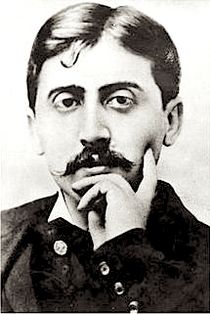
In the early 1890s, Hahn started working on his first opera, L'île du rêve. During this time, he met Marcel Proust in 1894. They quickly became very close friends. Proust once wrote, "Everything I have ever done has always been thanks to Reynaldo." Hahn even suggested the famous "petite phrase" (small musical phrase) that appears in Proust's famous novel À la recherche du temps perdu. This phrase was from Saint-Saëns's D minor violin sonata.
Hahn finished his studies at the Conservatoire. His teacher, Massenet, left the school in 1896, and Hahn left at the same time.
A Busy Composer and Conductor
In 1896, Hahn became very close friends with the actress Sarah Bernhardt. He often visited her, had lunch with her, traveled with her, and wrote music for her plays.
Hahn's first opera, L'île du rêve, was performed in 1898. Even with a good cast and conductor, the critics did not like it much, and it was only performed seven times. Around this time, Paris was very focused on the Dreyfus Affair, a big political scandal. Hahn, like Proust and Bernhardt, supported Alfred Dreyfus. The anti-Jewish feelings during this time upset Hahn, but his love for France remained strong.
In 1898, Hahn began working on more songs. He also started writing music reviews for the newspaper La Presse in 1899. In 1902, his second opera, La Carmélite, was performed. It was well-produced but did not become very popular. After this, Hahn focused less on operas.
In 1905, he wrote one of his most popular works, Le Bal de Béatrice d'Este. This suite for a small group of instruments is still one of his best-known and most performed pieces.
Hahn also became known as a conductor. In 1903, his performances of Mozart's Don Giovanni were praised for being light and true to Mozart's original score. In 1906, he conducted Don Giovanni at the Salzburg Festival, celebrating Mozart's 150th birthday.
In December 1907, Hahn officially became a French citizen. He continued to compose, including his Songs and Madrigals (1907), which used words by old French poets. He also wrote two ballets, La Fête chez Thérèse (1910) and Le Dieu bleu (1912).
War, Teaching, and New Successes
When World War I started in 1914, Hahn volunteered for the army, even though he was older than the age limit. He worked near the front lines and continued to compose when he could. He wrote music for his regiment and for shows for the soldiers. He was awarded the Croix de guerre and the Legion of Honour for his service.
After the war, Hahn became a professor of interpretation and singing at the École Normale de Musique de Paris. He was known for expecting high standards from singers and wrote a book about singing technique called Du chant (1921).
In 1921, Hahn was asked to write music for an operetta called Ciboulette. He was unsure at first because it was set in a famous market, like another popular operetta. But he accepted the job. While working on Ciboulette, Hahn lost his two closest friends, Proust and Bernhardt, who both passed away.
Ciboulette opened in April 1923 and was a huge success. It was performed many times in Paris during Hahn's life and is still performed today.
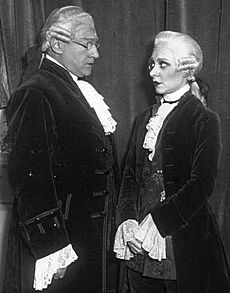
In 1924, Hahn was promoted in the Legion of Honour. The next year, he had another big success with the musical comedy Mozart. The actor and writer Sacha Guitry asked Hahn to write the music for this show, which was loosely based on Mozart's early life. Guitry and his wife, Yvonne Printemps, starred in it. The show opened in December 1925 and received great reviews. Critics said it was hard to tell where Mozart's music ended and Hahn's began, which was high praise. The show was very popular in Paris and later in London and on Broadway.
Later Years and Legacy
In 1930, Hahn composed a piano concerto. It was first performed in 1931 and became his most famous concert piece. He also wrote music for the operetta Brummell in 1931. In 1933, he became the music critic for Le Figaro newspaper. That same year, Ciboulette was made into a movie.
Hahn's only major work for the Paris Opéra was Le marchand de Venise, an opera based on Shakespeare's play. It premiered in 1935 and was very well received. Hahn continued to work with Sacha Guitry on other shows and composed music for many plays and films.
In the late 1930s, Hahn was again a prominent conductor, leading performances of Mozart's operas like The Magic Flute and The Marriage of Figaro. He was praised for staying true to Mozart's original scores.
When the Germans occupied Paris in 1940, Hahn, being of Jewish descent, left for Monaco to be safer. He returned to Paris in February 1945. He was elected to the Institut de France and became the director of the Paris Opéra. His last concert work, the Concerto provençal, was first broadcast in 1945.
In 1946, Hahn went on a concert tour. He became ill and had an operation for a brain tumor. Reynaldo Hahn passed away in Paris on January 28, 1947, at age 72. He was buried near his friend Marcel Proust in Père Lachaise Cemetery.
Hahn's Musical Style
Reynaldo Hahn's music often felt like it belonged to the late 1800s, a time known as fin de siècle Paris. He learned from his teacher Jules Massenet and was able to adapt his style to the newer sounds of the 1920s, like jazz and tango. He used instruments like the saxophone and piano in his orchestra. His works include chamber music, ballets, and orchestral pieces.
After his death, Hahn's music was not as well-known for a while. This period is sometimes called "crossing the desert." However, in the late 1900s, people became interested in his music again. Now, many of his songs are performed regularly in concerts.
His Famous Songs (Mélodies)
Hahn is best known for his songs, called mélodies. He wrote over 100 of them, mostly between 1888 and the end of the First World War. His early songs show the influence of Massenet, but he greatly admired Gabriel Fauré, another master of the mélodie. Hahn often used poems by writers like Victor Hugo and Paul Verlaine.
His song "Si mes vers avaient des ailes," written when he was only 13, shows his unique style. The piano part gently supports the singer, and the vocal line sounds natural, like speaking, but is also very beautiful to sing.
His first published collection of songs was Chansons grises (Songs in Grey, 1890). It included a setting of Verlaine's poem "La bonne chanson," which the poet himself preferred over Fauré's version. These songs showed amazing maturity for a 16-year-old.
Hahn continued to compose song cycles. Rondels (1898–99) used old French poems. Études latines (1900) set ten poems about ancient Greece and Rome. In Venezia (1901), he set six lyrics in a Venetian dialect. He also set English poems in Love Without Wings (1911) and Five Little Songs (1915).
Operas and Musical Comedies
Hahn completed five operas. His first, L'Île du rêve (1898), was set in Tahiti. It was not very successful at first but has been performed again more recently. His second opera, La Carmélite (1902), also did not become a regular part of the opera repertoire.
Le Marchand de Venise (1935) was Hahn's most successful serious opera. Critics praised its drama and the way it showed the characters. It was seen as light and charming, like Mozart's music.
Ciboulette, Hahn's first operetta, was his most popular and lasting stage work. It was a huge box office success and is still performed today. Critics have called it as good as other famous operettas like Fledermaus and The Merry Widow. Hahn wrote two more operettas, Brummell (1931) and Malvina (1935), which were also well-received.
His musical comedy Mozart (1925), written with Sacha Guitry, was also a big hit. It was praised for its charm and wit. Other musical comedies by Hahn include Le Temps d'aimer (1926) and Ô mon bel inconnu (1933).
Orchestral and Piano Music
One of Hahn's best-known orchestral works is Le Bal de Béatrice d'Este (1905). It uses a small group of instruments and sounds like a 15th-century Italian court party.
Hahn wrote two concertos. The Violin Concerto (1928) has a rich sound and moves between strong rhythms and lyrical melodies. The Piano Concerto (1931) is a lighter, charming piece.
He also composed music for over 20 plays and films between 1890 and 1939. This included music for a film version of La Dame aux Camélias. He also created ballet scores, including Le Dieu bleu (1912) for Sergei Diaghilev's Ballets russes.
Most of Hahn's solo piano works were written earlier in his career. Some are in traditional forms like waltzes and a sonatina. Others are more unusual, like Portraits de peintres (1894), meant to be played between spoken poems. His longest piano work is Le Rossignol éperdu (The Distraught Nightingale), written between 1902 and 1910. It has 53 short pieces.
Recordings of Hahn's Music
Many recordings of Hahn's music were made during his lifetime, especially his popular songs. Hahn himself made many recordings, singing and playing his own songs, as well as music by other composers like Mozart and Massenet.
Since the late 20th century, there has been a renewed interest in Hahn's works. Many of his songs have been recorded by famous singers. His complete piano music has also been recorded.
Several of Hahn's stage works have been recorded. Ciboulette was recorded in 1983 and again in 2013. The first recording of L'île du rêve was released in 2020. Excerpts from Mozart were recorded by Yvonne Printemps in 1925, and a complete recording was made in 1959.
Images for kids
-
Marcel Proust, Hahn's lifelong friend
See also
 In Spanish: Reynaldo Hahn para niños
In Spanish: Reynaldo Hahn para niños


